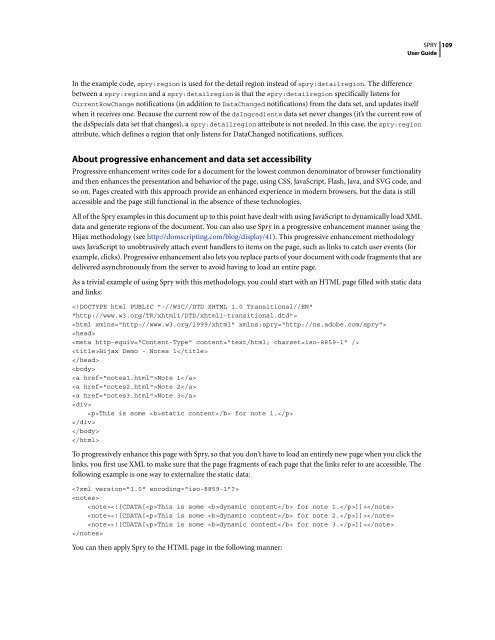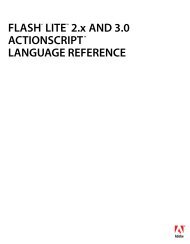Spry User Guide - Support - Adobe
Spry User Guide - Support - Adobe
Spry User Guide - Support - Adobe
Create successful ePaper yourself
Turn your PDF publications into a flip-book with our unique Google optimized e-Paper software.
In the example code, spry:region is used for the detail region instead of spry:detailregion. The difference<br />
between a spry:region and a spry:detailregion is that the spry:detailregion specifically listens for<br />
CurrentRowChange notifications (in addition to DataChanged notifications) from the data set, and updates itself<br />
when it receives one. Because the current row of the dsIngredients datasetneverchanges(it’sthecurrentrowof<br />
the dsSpecials data set that changes), a spry:detailregion attribute is not needed. In this case, the spry:region<br />
attribute, which defines a region that only listens for DataChanged notifications, suffices.<br />
About progressive enhancement and data set accessibility<br />
Progressive enhancement writes code for a document for the lowest common denominator of browser functionality<br />
and then enhances the presentation and behavior of the page, using CSS, JavaScript, Flash, Java, and SVG code, and<br />
so on. Pages created with this approach provide an enhanced experience in modern browsers, but the data is still<br />
accessible and the page still functional in the absence of these technologies.<br />
All of the <strong>Spry</strong> examples in this document up to this point have dealt with using JavaScript to dynamically load XML<br />
data and generate regions of the document. You can also use <strong>Spry</strong> in a progressive enhancement manner using the<br />
Hijax methodology (see http://domscripting.com/blog/display/41). This progressive enhancement methodology<br />
uses JavaScript to unobtrusively attach event handlers to items on the page, such as links to catch user events (for<br />
example, clicks). Progressive enhancement also lets you replace parts of your document with code fragments that are<br />
delivered asynchronously from the server to avoid having to load an entire page.<br />
Asatrivialexampleofusing<strong>Spry</strong>withthismethodology,youcouldstartwithanHTMLpagefilledwithstaticdata<br />
and links:<br />
<br />
<br />
<br />
<br />
Hijax Demo - Notes 1<br />
<br />
<br />
Note 1<br />
Note 2<br />
Note 3<br />
<br />
This is some static content for note 1.<br />
<br />
<br />
<br />
To progressively enhance this page with <strong>Spry</strong>, so that you don't have to load an entirely new page when you click the<br />
links, you first use XML to make sure that the page fragments of each page that the links refer to are accessible. The<br />
following example is one way to externalize the static data:<br />
<br />
<br />
This is some dynamic content for note 1.]]><br />
This is some dynamic content for note 2.]]><br />
This is some dynamic content for note 3.]]><br />
<br />
You can then apply <strong>Spry</strong> to the HTML page in the following manner:<br />
SPRY<br />
<strong>User</strong> <strong>Guide</strong><br />
109















